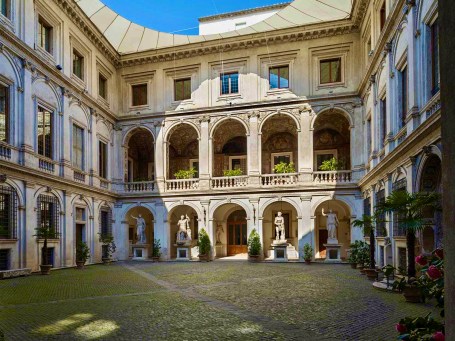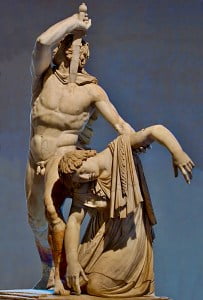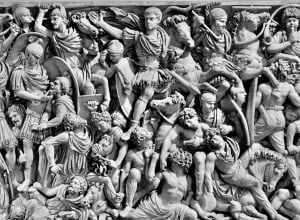Palazzo Altemps Rome | National Roman Museum | Rome Private Tours Boncompagni Ludovisi Collection guided customized itineraries and skip-the-line tickets.
Palazzo Altemps Rome | National Roman Museum | Rome Private Tours Boncompagni Ludovisi Collection
Rome exclusive guided customized itineraries.
Palazzo Altemps in Rome houses the Boncompagni Ludovisi Collection, one of the most collections of ancient sculptures in Italy. The collection was acquired in 1621/1623 for the decoration of the Villa al Quirinale by the famous Cardinal Ludovico Ludovisi. Among the various works on display, perhaps one of the most important is the Ludovisi Throne, an original Greek opera found in the 19th century. The collection counts 104 sculptures now exhibited in Palazzo Altemps, 15th century, recently restored. In the splendid frescoed rooms, many ancient works in marble are exhibited. In addition to the Ludovisi collection, this museum exhibits works belonging to the Altemps, Mattei, and Del Drago collections
Certainly among the most fascinating sculptures, there is that of the Suicidal Rooster.

Among the various works on display, you can also admire the Egyptian collection with important decorative remains from the sanctuary of Isis and Serapis in Campo Marzio and from the Janiculum in Rome.
This collection, founded by Cardinal Ludovisi in the first half of the 17th century to ornamen t his famous villa, was once the tiny Cloister of the ex-Carthusian.
The mosaic floor, one of the largest in existence, measuring nearly 400 square meters, was found in the excavation of “Castel Porziano,” the hunting park of king Victor Emanuel III, among the ruins of an ancient Roman bathing establishment. It represents hunting scenes of the amphitheater and mythological subjects.
Beginning by the first Wing right on entering:
Palazzo Altemps Rome | Beautiful female Statue is remarkable for the drapery and the noble, dignified attitude, dating from the Greek archaic period, 5th cent. B.C.
As the God of eloquence, Mercury attributed to the first manner of Phidias when he was still under the influence of the art of Myron.
Minerva is a Hellenistic copy by Antiochios of the famous Minerva by Phidias, which ornamented the temple of the goddess in Athens. On the drapery near the right foot is the name of the copyist.
“Efebus”. A young man seated on the floor, supposed to represent an “Efebus”. The Statue is very much restored.
Venus. One of the many copies of the Venus of Cnidos larger than life-size.
Palazzo Altemps Rome | The Gaul. A colossal group represents a conquered leader of the Gauls, supporting his dead wife with his left arm, whom he has just killed, while he is stabbing himself with his right hand rather than surrendering to the victor. The group is a beautiful piece of Hellenistic quality. It is a copy of the famous original bronze of the Dying Gaul of the Capitoline museum. Attalus erected it, king of Pergamus, in the Temple of Athena Polias in this city and the Acropoli of Athens in 250B.C. to commemorate the victories he gained over the Galatians when they invaded Asia. The original was the work of four artists of the school of Pergamus: Antigonos, Phyromacos, Epigonos, and Stratonikos. Even if the erroneous restoration spoiled it, it is awe-inspiring and most noteworthy for the beautiful rendering of the determined and ferocious expression on the barbarian’s face.
In the next cabinet, right, is the: Birth of Venus. The marble throne is one of the greatest works of early Greek art, probably used as a pedestal for a statue and representing the birth of Venus, a delicate piece of quality of the 5th cent. B.C. This charming work in Pentelic marble has on the sides two reliefs, one representing a priestess in the act of offering incense, the other figure of a girl playing the double flute.

The throne is a delicate and rare specimen of the developed Greek archaic art, as demonstrated by the inexperience in the eyes represented straight in the faces on profile.
The fomuos Ludovisi Juno. A colossal head of a goddess, calm, solemn, and dignified, an archaic Greek original of the early 5th century B.C. Although generally known under the name of Juno, opinions vary very much as to the subject the Statue was intended to represent.
Mars. The celebrated Ludovisi Mars, a very singular and peculiar representation of the God of War. The melancholy, dreamy and reflective pose of the young Mars is explained by the presence of the Cupid, who denotes that the God of War is liable to undergo the influence of the little God of Love. It recalls the art of Lysippus. The most important group in the 3rd Wing is: Oreste and Electra meeting each other on the tomb of their father;
Palazzo Altemps Rome | The hair of Electra is cut short as a sign of mourning for her father’s death during the funeral stele. Near the leg of Oreste indicates their father’s tomb. Electra is represented as urging her brother to revenge for the murder of their father by assassinating their mother, Clytemnestra. The group is the work of Menelaus, an artist of the first century B.C. The full signature is visible in the support: official Rome Guide, Rome city Tours.

National Roman Museum | Large Sarcophagus. We are representing a battle scene between Romans and Barbarians. High up in the center is the leader of the Romans , most likely a portrait of some Roman General. Leaving the Ludovisi collection, a door at the end of a Vestibule admits us to the:
Large Cloister is one of the purest designs in Rome. It is ornamented by hundreds of beautiful columns, is a gem of architecture, and is attributed to Michelangelo, who transformed a large part of the Baths of Diocletian into a Carthusian convent. The Garden in the center is beautiful with beautiful cypress trees, said to have been planted by Michelangelo.
The arcades are collected and preserved fragments of statues, pedestals, sarcophagi, etc. Especially in the North West, they are very well maintained and give an idea of the monk’s life.
In these cells, the monks could live alone a life of retirement in the strictest seclusion from the outer world, every one having a little garden and loggia. (Tour Guide of Rome).
In the second Wing of the large Cloister, we see the Lid of a very rare sarcophagus; of a married couple, divided by religion but united by love. The husband, who must have been a follower of Christ, was cremated, and his wife, a pagan. Her ashes are preserved in the urn inside the sarcophagus of her husband: official Rome Guide, Rome city Tours. Rome Private Tours
At the bottom of this Wing, a large mosaic represents the worship of the animals sacred to the Nile.
National Roman Museum | Palazzo Altemps Rome | Nearby (at the beginning of the third Wing) are the: Ludi seculars. This finely and magnificently cut inscription has great historical interest as it reminds us of the famous “Ludi Suculares” celebrated under the reign of Augustus in 17 B.C. and of the “Carmen Seculares” just written by Horace and sung by boys and girls of patrician families. Rome tours and sightseeing. Rome Private Tours




